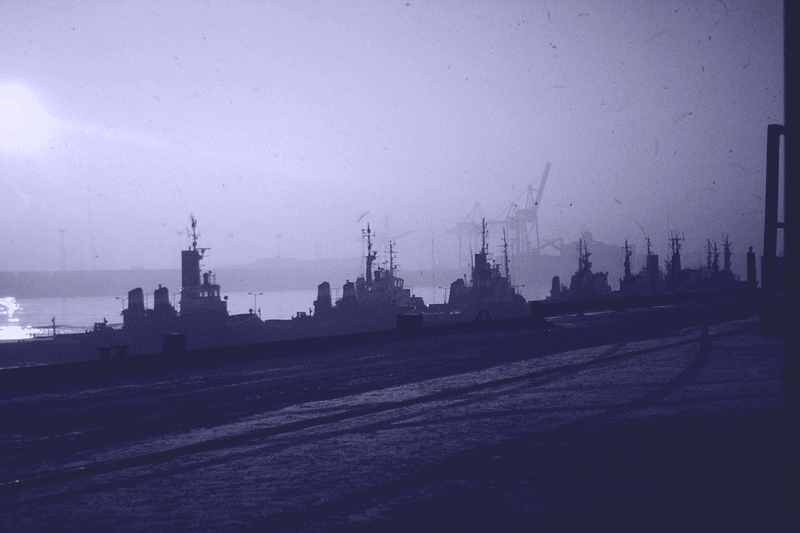A - B - C - D - E - F - G - H - I - J - K - L - M - N - O - P - Q - R - S - T - U - V - W - X - Y - Z
| Baltic Dry Index (BDI) | Assessment of the average price to ship raw materials (such as coal, iron ore, cement and grains) on a number of shipping routes and by ship size. It is an indicator of the cost paid to ship raw materials on global markets and an important component of input costs. As such, the index is considered as a leading indicator (forward looking) of economic activity since it involves events taking place at the earlier stages of global commodity chains. |
| Barge | a non-motorized water vessel, usually flat-bottomed and towed or pushed by other craft, used for transporting freight. Dominantly used on river systems. |
| Bill of Loading (B/L) | A document that establishes the terms of a contract between a shipper and a transportation company. It serves as a document of title, a contract of carriage and a receipt for goods. Amended B/L: B/L requiring updates that do not change financial status; this is slightly different from corrected B/L. B/L Terms & Conditions: the fine print on B/L defines what the carrier can and cannot do, including the carrier s liabilities and contractual agreements. B/L s Status: represents whether the bill of lading has been input, rated, reconciled, printed, or released to the customer. B/Ls Type: refers to the type of B/L being issued. Some examples are: a Memo (ME), Original (OBL), Non negotiable, Corrected (CBL) or Amended (AM) B/L. Canceled B/L: B/L status; used to cancel a processed B/L usually per shippers request; different from voided B/L. Clean B/L: A B/L which bears no superimposed clause or notation which declares a defective condition of the goods and/or the packaging. Combined B/L: B/L that covers cargo moving over various transports. Consolidated B/L: B/L combined or consolidated from two or more B/L s. Corrected B/L: B/L requiring any update which results in money or other financially related changes. Domestic B/L: Non-negotiable B/L primarily containing routing details; usually used by truckers and freight forwarders. Duplicate B/L: Another original Bill of Lading set if first set is lost. also known as reissued B/L. Express B/L: Non-negotiable B/L where there are no hard copies of originals printed. Freight B/L: A contract of carriage between a shipper and forwarder (who is usually a NVOCC); a non-negotiable document. Government B/L (GBL): A bill of lading issued by the U.S. government. Hitchment B/L: B/L covering parts of a shipment which are loaded at more than one location. Hitchment B/L usually consists of two parts, hitchment and hitchment memo. The hitchment portion usually covers the majority of a divided shipment and carries the entire revenue. House B/L: B/L issued by a freight forwarder or consolidator covering a single shipment containing the names, addresses and specific description of the goods shipped. Intermodal B/L: B/L covering cargo moving via multimodal means. Also known as Combined Transport B/L, or Multimodal B/L. Long Form B/L: B/L form with all Terms & Conditions written on it. Most B/L s are short form which incorporate the long form clauses by reference. Memo B/L: Unfreighted B/L with no charges listed. Military B/L: B/L issued by the U.S. military; also known as GBL, or Form DD1252. B/L Numbers: U.S. Customs s standardized B/L numbering format to facilitate electronic communications and to make each B/L number unique. Negotiable B/L: The B/L is a title document to the goods, issued to the order of a party, usually the shipper, whose endorsement is required to effect is negotiation. Thus, a shipper s order (negotiable) B/L can be bought, sold, or traded while goods are in transit and is commonly used for letter-of-credit transactions. The buyer must submit the original B/L to the carrier in order to take possession of the goods. Non-Negotiable B/L: See Straight B/L. Sometimes means a file copy of a B/L. Onboard B/L: B/L validated at the time of loading to transport. Onboard Air, Boxcar, Container, Rail, Truck and Vessel are the most common types. Optional Discharge B/L: B/L covering cargo with more than one discharge point option possibility. Order B/L: See Negotiable B/L. Original B/L: The part of the B/L set that has value, especially when negotiable; rest of set are only informational file copies. Abbreviated as OBL. Received for Shipment B/L: Validated at time cargo is received by ocean carrier to commence movement but before being validated as Onboard. Reconciled B/L: B/L set which has completed a prescribed number of edits between the shippers instructions and the actual shipment received. This produces a very accurate B/L. Short Term B/L: Opposite of Long Form B/L, a B/L without the Terms & Conditions written on it. Also known as a Short Form B/L. The terms are incorporated by reference to the long form B/L. Split B/L: One of two or more B/L s which have been split from a single B/L. Stale B/L: A late B/L; in banking, a B/L which has passed the time deadline of the L/C and is void. Straight (Consignment) B/L: Indicates the shipper will deliver the goods to the consignee. It does not convey title (non-negotiable). Most often used when the goods have been pre-paid. To Order B/L: See Negotiable B/L. Unique B/L Identifier: U.S. Customs standardization: four-alpha code unique to each carrier placed in front of nine digit B/L number; APL unique B/L Identifier is APLU. Sea-land uses SEAU. These prefixes are also used as the container identification. Voided B/L: Related to Consolidated B/L; those B/L absorbed in the combining process. Different from Canceled B/L. |
| BLANKET BOND | A bond covering a group of persons, articles or properties. |
| BREAK-BULK CARGO | Refers to freight, both dry or liquid, that is not packaged such as minerals (oil, coal, iron ore) and grains. It often requires the use of specialized ships such as oil tankers as well as specialized transshipment and storage facilities. Conventionally, this cargo has a single origin, destination and client. It is also prone to economies of scale. |
| BREAK-EVEN WEIGHT | Weight at which it is cheaper to charge the lower rate for the next higher weight-break multiplied by the minimum weight indicated, than to charge the higher rate for the actual weight of the shipment (air cargo). |
| BULK CARRIERS | All vessels designed to carry bulk cargo such as grain, fertilizers, ore and oil. |
| BULK TERMINAL | A purpose-designed berth or mooring for handling liquid or dry commodities, in unpackaged bulk form, such as oil, grain, ore, and coal. Bulk terminals typically are installed with specialized cargo handling equipment such as pipelines, conveyors, pneumatic evacuators, cranes with clamshell grabs, and rail lines to accommodate cargo handling operations with ships or barges. Commodity-specific storage facilities such as grain silos, petroleum storage tanks, and coal stock yards are also located at these terminals. |
| BUNKER CHARGE | An extra charge sometimes added to steamship freight rates; justified by higher fuel costs. (known as Fuel Adjustment Factor or FAF.) |
| CAD | Cash against Documents. Payment condition which implies transfer of title at time of payment. |
| CAF | Currency Adjustment Factor. Adjustment applied by shipping lines or liner conferences on freight rates to offset losses or gains for carriers resulting from fluctuations in exchange rates of tariff currencies. |
| CARGO TONNAGE | Most ocean freight is billed on the basis of weight or measurement tons (W/M). Weight tons can be expressed in short tons of 2000 pounds, long tons of 2240 pounds or metric tons of 1000 kilos (2204.62 pounds). Measurement tons are usually expressed as cargo measurement of 40 cubic feet (1.12 meters) or cubic meters (35.3 cubic feet.) |
| CARNET | a custom document permitting the holder to temporarily carry or send merchandise into certain foreign countries (for display, demonstration or similar purposes) without paying duties or posting bonds. |
| Carriage of Goods by Sea Act | Cash against Documents. Payment condition which implies transfer of title at time of payment. |
| CFS - Container Freight Station | Term CFS at loading ports refers to the location designated by carriers for the receiving of cargo to be packed into containers by the carrier. At discharge ports, the term CFS refers to the location designated by carriers in the port area for unpacking and delivery of cargo. |
| CONSOLIDATION | Cargo containing shipments of two or more shippers or suppliers. Containerload shipments may be consolidated for one or more consignees. |
| Contractual Port of Loading | Port at which an ocean vessel does not call, but which is equalized with the actual port of call and upon which inland haulage services and inland tariffs are based. Note: Generally speaking it is seen as the port mentioned on the B/L from which cargo is accepted (e.g. delivered by the consignee for sea transport). |
| Customs Clearance Agent | Customs broker or other agent of the consignee designated to perform customs clearance services for the consignee |
| CUSTOMS INVOICE | Document required by customs in an importing country in which the seller states the price (e.g. selling price, price of identical goods), and specifies costs for freight, insurance and packing, etc., terms of delivery and payment. This is for the purpose of determining the customs value in the importing country of goods consigned to that country. |
A - B - C - D - E - F - G - H - I - J - K - L - M - N - O - P - Q - R - S - T - U - V - W - X - Y - Z













